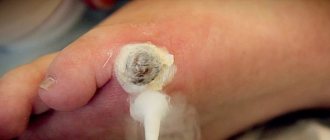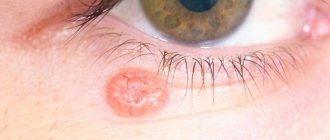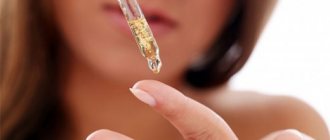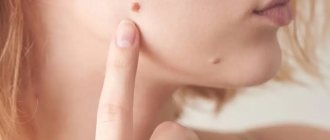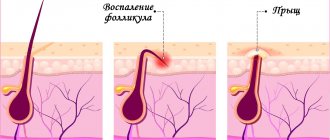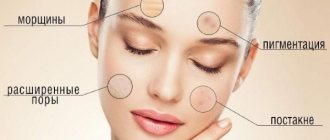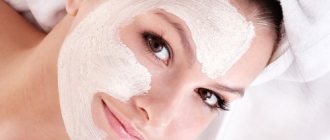Causes of warts on hands
For warts to appear, you must be infected with a certain type of human papillomavirus (HPV). It is tissue specific. This means that each type of virus requires a certain type of epithelium. Therefore, warts can have different localizations and differ visually.
Benign neoplasms are most often caused by HPV types 2, 27 and 57, as well as 4 and 1. Less commonly, 3, 7, 10, 28, 41, 65, 88, 59. But other HPVs can also be detected.
You can become infected from a person who has a rash on the skin or is a carrier of the virus. But for transmission of infection, simple contact is not enough; the following conditions are necessary:
- high viral load - the carrier must have a sufficient number of pathogens so that they can resist the immune system of a healthy person;
- contact with the skin of a large number of viral particles;
- prolonged contact with infection - the risk of infection is higher if you do not wash your hands after contact with an infected person;
- microdamage to the skin, trauma and wounds, foci of inflammation at the site of contact;
- reduced general or local immune status in chronic diseases, frequent infections or diabetes.
Therefore, warts on the hands appear more easily in children who may play with other people's toys and often have hangnails and minor injuries on their hands. The older a person is, the lower the likelihood of developing an infection. But this condition changes in old age and with a large number of chronic diseases.
The virus is transmitted through contact and household contact. After penetration into epithelial cells, it can exist in a latent form for a long time. The immune system does not react in this case, because The pathogen is located in its own cells. But when the immune status decreases, the process of HPV replication starts, it actively divides, causes tissue hyperplasia and the appearance of papillomatous growths.
The pathogen can then spread throughout the body by autoinoculation. Therefore, after one wart appears on a finger, additional rashes appear nearby or in another place over time.
What to do if a wart hurts
Doctors strongly do not recommend treating a painful growth on your own. What to do if a wart hurts, only a competent specialist knows, with whom you should make an appointment. In this case, a person can provide first aid to himself. Its actions will directly depend on what specific processes occur with the benign neoplasm.
The wart bleeds due to damage
The drug has antimicrobial and anti-inflammatory effects
If the growth on the leg or in other areas has been mechanically damaged, it will hurt when pressed and pressed. Also, pain may persist even without touching the problem area. In this case, you should immediately treat the wart with an antiseptic solution. Suitable for these purposes:
- Hydrogen peroxide (3%).
- Miramistin.
- Chlorhexidine.
- Furacilin.
In extreme cases, it is allowed to use medical alcohol.
The wart is inflamed and festering
The presence of purulent masses in the growth indicates the addition of a bacterial infection. Only antibiotics can cope with it. But initially you need to wash the problem area with an antiseptic. After this, it is advisable to apply a tampon with an ointment containing an antibacterial substance to the wart. Next, it needs to be fixed with adhesive tape.
The bandage with antibacterial ointment must be changed 2 times a day. A clean swab with a new portion of the treatment must be applied to the wart.
Wart cut off
If a person accidentally manages to remove a wart or a couple of papillomas from a problem area by cutting them off, he will begin to bleed. To stop it, you need to place the area under cold water or wipe it with an ice cube. Then the wart is treated with an antiseptic and a sterile bandage is applied to it.
This is just the first aid that needs to be provided to a person with a problematic wart. After this, the growth should be shown to a specialist.
What does a wart look like?
In most cases, warts are located on the hands, but sometimes they can appear in other areas - on the pads of the fingers or palms, on the soles of the feet, on the elbows and knees. What a wart looks like depends on the type of virus, the location of the tumor, and the duration of its existence.
Common warts are round formations with a diameter of 2-10 mm. At first they rise slightly above the surface of the skin, but gradually increase in size and resemble a dense pea. The color corresponds to the epidermis, ranging from gray, yellowish, pale pink, brown. Sometimes small black dots appear on the surface.
The surface of the formations is rough. They are usually asymptomatic and not accompanied by unpleasant sensations. But when localized in areas of high pressure (sole, fingertips) or friction, pain appears. Some warts can become injured and bleed.
Sometimes formations take on an atypical shape. When localized on the scalp, they can take on the appearance of cauliflower on a stalk. There are thread-like warts. In adolescents, flat-shaped formations may appear, which are localized on the fingers or toes. They almost do not rise above the epidermis, and their surface is rough to the touch.
When self-infection of neighboring areas of the epidermis occurs, warts may appear in the form of foci and merge into a larger one. This is most often observed in plantar forms of pathology.
Possible complications
The occurrence of complications after removal of a growth is associated with the wrong choice of treatment method, an unsuccessful procedure, or non-compliance with the rules for caring for the wound.
Scarring
The most common complication after a wart removal procedure is scarring of epithelial tissue. The reason for the development of such a pathological process may be:
- Inexperience of the specialist who performed the manipulation;
- Genetic tendency to form colloidal scars;
- Violation of wound care rules in the postoperative period;
- Infection of the damaged area;
- Premature removal of the crust;
- Excision of large deep tumors.
The effect of a laser beam on the epithelium is similar to a sunburn. Therefore, the area of skin treated with the laser turns red. If there is increased individual sensitivity to solar radiation, after the procedure, swelling and redness of the skin around the removed tumor may occur. In especially severe cases, blisters are observed, which scar over time and acquire a brown tint.
Such complications can be avoided if you care for the wound in accordance with the recommendations of your doctor. If, despite all your efforts, swelling and redness does not go away, you should not self-medicate. Seek advice from a specialist.
Inflammatory process
The inflammatory process is accompanied by symptoms such as redness of the damaged area, pain and fever. Don't be afraid. This is the body's reaction to the manipulation. All symptoms should disappear within five days.
If these symptoms do not disappear for more than seven days, you should consult a doctor. Since a long-term inflammatory process can be a consequence of infection of the wound. You will need to treat the damaged area with an antiseptic or take a course of antibiotics.
Pain syndrome can be observed until the wound is completely healed. This is due to the patient's low pain threshold. If painful sensations are accompanied by purulent discharge, this indicates the development of a secondary infection. Contact the specialist who performed the manipulation. He will treat the damaged skin with an antiseptic and, if necessary, apply stitches. In addition, the doctor will prescribe a pain reliever to relieve pain.
Classification of viral warts
The type of wart a person has is determined by its external structure. It depends on the location and characteristics of the type of HPV that caused the disease. The following types are distinguished:
- vulgar - appears in any place described earlier, most often on the hands;
- palmoplantar – most often painful rashes on the plantar part of the feet or palms;
- mosaic - multiple rashes merging into one plaque, usually on the soles;
- cystic - a cavity with cheesy contents is formed inside the wart, the surface is soft, they form on the pressing side of the sole;
- flat – the formation almost does not rise above the surface of the skin, resembles a plaque in shape;
- thread-like - thin horny formations on the skin of the eyelids, face, neck, sometimes in the shape of a fern leaf;
- “butcher’s” warts are hypertrophic formations that have the shape of a cauliflower and are located on the back of the hands. Characteristic for people who have constant contact with raw meat;
- focal epithelial hyperplasia - multiple light warts that grow on the inner surface of the lip and can spread to the gums and oral mucosa;
- epidermodysplasia verruciformis - rashes similar to small warts cover the skin of the forearms, legs, face, back of the hands, and can merge.
Some types of HPV cause the formation of anogenital warts, which are located on the skin of the perineum, around the anus.
Diagnosis of warts and papillomas
Examination of patients with viral skin lesions begins with collecting anamnesis and examining the skin. The doctor will determine the location of the wart and the number of rashes. special instrumental diagnostic methods, dermatoscopy are not required. In most cases, making a diagnosis is not difficult.
Laboratory diagnostic methods are not very informative. They are only necessary in patients with suspected HIV infection or other immunodeficiency conditions. If the total area of the rash is more than 2 cm2 or the number of individual warts is more than 5, it is recommended to schedule a consultation with an immunologist.
Differential diagnosis is carried out with the following diseases:
- cutaneous horn;
- seborrheic keratosis;
- acrochordon;
- lichen planus;
- squamous cell carcinoma.
In rare cases, if a tumor is suspected of being malignant, a biopsy is required.
Treatment of warts
In rare cases, small formations disappear on their own without special treatment. But this happens with good resistance of the immune system. More often, this scenario is possible in childhood or adolescence.
In other cases, especially in older people and with a reduced immune status, self-healing is excluded. And if the body's resistance is insufficient, warts may appear in other areas.
Using special products prescribed by a doctor, you can carry out treatment at home. But this method is quite lengthy; it takes several weeks for a noticeable result to appear. Modern methods of destruction make it possible to get rid of rashes in one visit to the doctor. Also, a professional approach to therapy reduces the risk of complications or the appearance of rough scars.
Traditional methods for warts
Most people, when warts appear on their hands, do not consult a doctor, but use traditional methods of treatment. The following methods are popular:
- cauterization with celandine juice - the method is used in the spring and summer, when fresh plants can be found. Cauterization is done immediately after picking the branch, applying a small amount of yellow-orange juice to the wart. The method is effective, but time consuming and not suitable for urban residents;
- rubbing with garlic - daily you need to rub with a cut of a clove of garlic, treatment lasts several weeks, does not always help;
- compresses made from acetic acid are dangerous because they can cause a chemical burn on healthy skin around the wart; they cannot be used on the face, eyelids, neck, or ears;
- essential oils - applied pointwise to skin formations, but the effect is impossible to predict.
Other folk methods are also used to treat warts, which are not always effective and can be dangerous. Large formations that rise above the surface of the skin are suggested to be tied at the base with a strong thread, causing disruption of blood flow and the death of the wart. But this is a painful method, and its complication can be bleeding from the base of the growth.
Traditional methods of treating warts do not have evidence of effectiveness and safety. Therefore, their use is not recommended.
Remedies for warts
Local agents, when applied to a wart, cause tissue destruction and gradual mummification. A few days after the initial treatment, it changes color and gradually dries out. Healthy skin remains in its place.
The following wart remedies are used for destruction:
- acid solutions - nitric, acetic, oxalic and lactic acid are used in various combinations. The liquid is applied to the degreased surface with a special capillary or spatula, trying to avoid treating healthy skin. the procedure is carried out until the surface of the wart turns yellow. This is an indicator of a fairly deep impact and a guarantee of future mummification.
- solution of zinc chloropropionate and chloropropionic acid. It is applied to the affected areas of the skin, avoiding contact with healthy ones. During one visit to the doctor, the solution is applied 2-3 times. After this, the wart turns gray-yellow, and on the soles, gray-white. But getting rid of vulgar warts in one procedure is not always possible. Therefore, it is repeated 1-2 times, maintaining an interval of 10-14 days.
Some people buy wart remedies at the pharmacy, which are created based on traditional methods. These include infusions of celandine and wormwood. But their effectiveness and duration of therapy are the same as those of plants.
What products relieve inflammation on the skin?
The inflammatory process can be relieved if you treat the wart growth or what remains after it daily with a solution of ordinary potassium permanganate or brilliant green. You can use (but on the recommendation of a doctor and strictly according to the instructions) wound healing drugs:
It is not recommended to use various types of cosmetics, scrubs, and all kinds of gels. Sunscreens can be applied only when the tissue has completely healed and the scab has fallen off. Do not forget that any folk remedies or cosmetic products can be harmful, and an allergic reaction may occur to them.
Wart removal
Warts are often a cosmetic defect. But sometimes they cause physical discomfort and pain. To remove warts, destructive methods are used that allow you to get rid of the formation in one visit to the clinic. Hospitalization is not required.
Destruction occurs due to the action of physical factors. It can be:
- low temperature;
- laser radiation;
- radio waves;
- electricity.
Surgeries to remove warts are practically not used.
When choosing a treatment method, the doctor takes into account the size of the formation and its location. After using destructive methods of treatment, rough scars rarely form, because the basal layer of the epidermis remains unaffected.
But you need to remember that removing warts does not guarantee a complete cure. If the virus has managed to spread to other epithelial cells, the rash may reappear under the influence of provoking factors.
Preparing to remove a wart
Benign skin tumors are removed on an outpatient basis. This does not require special examination or lengthy preparation. The manipulation is performed under local anesthesia, so there is no need to diet or refuse food on the day of treatment.
But when visiting a doctor, you need to make sure that the skin in the lesion is clean; women are not recommended to wear cosmetics if they plan to remove warts on their face. Do not apply cream or other cosmetics to your hands and feet.
Laser removal of warts
Clinics offer the most modern and safe way to remove warts using a laser. It acts precisely and does not injure surrounding tissues. The advantages of laser wart removal are that there is no risk of wound infection, because there is no contact with the surgical instrument.
Removal occurs layer by layer, the laser beam evaporates the surface of the cells that form the growth on the skin. In this case, bleeding does not develop; the vessels at the base simultaneously coagulate.
Laser treatment may require local anesthesia. Depending on the location and size of the wart, a spray with an anesthetic is used or infiltrative anesthesia is performed with Lidocaine or Articaine.
Laser destruction is carried out layer by layer using continuous radiation. Exposure time from 2 seconds to 3 minutes. The doctor focuses on the size and location of the formation. Sometimes in large warts with a large shaft it is necessary to remove the scab after coagulation. It is excised with scissors, and the bottom of the wound is re-cauterized with a laser and treated with hydrogen peroxide.
Laser treatment can be used to localize warts on the hands, feet and face. The formation can be removed in one procedure.
Removing warts with nitrogen
The liquid nitrogen solution has a temperature of -127°C. When interacting with tissues, it causes instant freezing and cell membranes are destroyed. This leads to destruction of the wart. Nitrous oxide and carbon dioxide can also be used as a cooling agent, which does not affect the effectiveness of treatment.
To cauterize a wart with liquid nitrogen, use a special cryoprobe with a metal attachment. It has a round shape and a smooth surface for better contact with tissues. The cryoprobe is placed in a liquid nitrogen solution and then pressed firmly onto the affected area of the skin. Exposure time 1-5 minutes.
Use liquid nitrogen and other methods of destruction near the nail or on the side of the finger with caution. Damage to the nail growth zone can cause it to become deformed.
A scab forms at the site of the wart, which comes off the skin after 1 week. Sometimes cauterization alone is not enough. Repeated is carried out after 7-10 days.
Cauterization of warts with Surgitron and an electrocoagulator
Radiosurgical treatment is used to remove warts. The procedure is also performed under local anesthesia. The radio wave generated by the device passes through the tissue and causes local heating.
Prolonged exposure leads to the destruction of pathological cells and destruction of the wart. In this case, tissue coagulation does not occur.
Treatment with radiosurgery takes a few minutes. You can get rid of warts this way in one procedure. There is no risk of complications after this treatment.
Removal of warts by electrocoagulation is carried out layer by layer. The needle electrode comes into contact with the tissues, and the electric current causes their destruction. To reduce discomfort, the procedure is performed under local anesthesia.
Further care
After the crust falls off, you need to continue to properly care for the area where the wart was located:
- Use Contractubex ointment according to the instructions. This product will help prevent the formation of scars. Your doctor will tell you whether this medicine can be used in your situation.
- Do not epilate areas where there was a wart for at least three weeks.
- Protect skin from exposure to sunlight (for at least a month). When going outside, use a cream with a high level of ultraviolet protection (50 SPF).
- For a month or even more (depending on the doctor’s recommendations), avoid visiting the bathhouse and swimming pool, taking a hot bath, or swimming in open water.
- Refuse to use aggressive care products until the skin is completely restored.
Neglect of these simple rules is fraught with infection of the wound, the appearance of a hypertrophic or keloid scar, and abnormal skin pigmentation.
For more effective skin regeneration, it would be useful to take a course of multivitamins. Thus, vitamins A and E, as well as vitamin C, can promote healing. Such products also improve the elasticity of the skin and help improve immunity, preventing relapse of the disease.
Wart after removal
The doctor gives recommendations on how to care for the skin area after wart removal. The manipulations affect the surface layers of tissue, so stitches are not needed. But a sterile bandage is applied to the wound after the wart to prevent dirt from entering.
It is recommended to treat the wound after cauterization with a solution of brilliant green, which has a drying effect. Dressings are carried out for 5-7 days.
At the site of cauterization of the wart with nitrogen, radio waves or an electrocoagulator, a dense scab is formed. Healthy skin forms underneath. It is not recommended to remove it ahead of time; this will lead to tissue damage and scar formation.
Removing warts does not guarantee that the rash will not reappear over time. If the virus has spread to other epithelial cells, then when the immune defense is reduced, its replication will start again.
Long-term recovery
If a wound on the skin after laser removal does not heal for a long time, this indicates some disturbance in the body’s functioning and can contribute to the occurrence of various complications. A similar situation can occur when:
- If the patient has any diseases, for example, diabetes, decreased blood clotting, hormonal imbalance, etc.
- Insufficient activity of the immune system. In such a situation, the body has problems repairing even minor damage to the skin. And it is important to identify the causes of immune suppression and correct them.
- Proper care of the wound after surgery is not enough.
- The patient has bad habits - alcohol, drug or nicotine addiction. It is believed that all of them disrupt skin regeneration processes, impede proper blood circulation and inhibit recovery.
Where to remove a wart
Benign skin tumors that do not have the risk of malignant degeneration can be removed on an outpatient basis, as well as in cosmetologist’s offices. The manipulation is carried out within 15-20 minutes.
In our Surgery Center you can remove a wart using modern methods. We use laser machines, which make it possible to carry out the procedure in one visit to the doctor without risk to health. But the doctor may prescribe other methods of removal - cryodestruction or electrocoagulation.
Make an appointment at the Surgery Center by calling the number listed on the website. Our surgeons will see you at a convenient time and help you choose a gentle method for treating warts.
